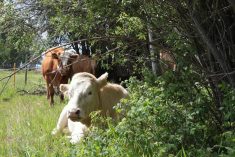beff 911 As water levels in dugouts get shallower, the water temperature and evaporation increase
Water is the most essential nutrient of life and even though most areas have more than enough this year, it’s still a good time to talk about water deprivation.
We need to focus on the preventive and what to watch for should water deprivation become a problem. Many articles have been written about water quality resulting in reduced weight gains. Depending on the water source, more issues with foot rot and potential exposure to algal poisoning are other issues to contend with as water levels get low.
Read Also

Mosquito-borne virus could be devastating to sheep breeding operations
Cache Valley virus, a mosquito-borne disease that infects small ruminants, could be a devastating hit to small operations.
There are some common-sense principles to be aware of with low water tables, dugouts drop, and common water sources dry up. Water supply must be monitored frequently. As dugouts recede, solar pumps — depending on their capacity — may not be able to lift the water up into the troughs. As well, algae and aquatic plants may plug up the pump. Have as much storage capacity in the watering troughs as possible — ideally at least a couple of days’ supply in the event of a pump failure. In wet years, there is a lot of surface water in sloughs and low spots that livestock can turn to if there’s a failure with a watering bowl or water pump. Dry years often don’t give us this luxury.
As water levels in dugouts get shallower, the water temperature and evaporation increase. Some farmers have been caught when they didn’t monitor the depth of water supply and are left with a muddy bog in a matter of a few days.
Water consumption does rise dramatically in the summer. A good rule of thumb is water consumption is 10 per cent of body weight in the summer and about half that in the winter. So 100 good-size, 1,500-pound cows with early-born calves at foot, which are say 500 pounds, would require almost 2,000 gallons (or 20,000 pounds) of water on a hot day. Each cubic foot of water in your dugout contains 6.24 gallons and when calculating water needs, don’t forget to factor in evaporation and seepage as well as consumption.
Check supplies
That’s why regular summertime checks of water supplies, tanks, solar pumps, etc. is a must. Only a few days without water can become life threatening with livestock, not to mention the production losses which occur.
The first signs of water deprivation are sunken flanks, much like you would see with sick cattle where feed consumption and, in many cases water consumption, is reduced. Cattle may start acting overly quiet; hanging out by the water source or by the gates trying to get out. I have even seen water deprivation in winter in cases where watering bowls were shocking the cattle and they couldn’t drink. So don’t think it is entirely a summer phenomena.
The different behaviour I described comes initially from thirst in the throat area just as we humans experience. Beyond that, you get cellular dehydration and the typical sunken eyes, very tacky skin, and cessation of urinary output. If found in this state, provide water (preferably low in salinity to avoid salt poisoning) as quickly as possible. Gradual replenishment is the ideal but realistically livestock are going to be fighting to get to it. So allowing as much room as possible by providing more water tanks is about all you can do.
Keep in mind that replacing water may not be the end of your problems. Pregnant cattle may abort or resorb their fetuses. As we become dehydrated, the blood becomes thicker. With the blood vessels constricting, the non-essential organs (such as the uterus) are deprived of blood supply. This is all in the name of survival for the animal. I have seen cattle and bison that were water deprived, but still alive, take on a good drink of water and later die from metabolic problems. The tissues are very dry at the cellular level and when replenished quickly, metabolic changes and imbalances occur that can send the animals into shock and death. On post-mortem there is often liquefaction of the fat, which has also occurred.
Any time there is water deprivation and it was preventable, there may be charges laid by the SPCA even though it might be deemed an accident.
As much as feed is important to survival, special consideration must always be paid to the water supply. Both the quality and, especially the quantity, of water must be adequate. Water deprivation is a very unpleasant way to die, and survival could still result in permanent damage to organs such as the kidneys.
Lots of mud-stained legs, flanks and underbellies often indicate livestock are having difficulty reaching adequate water supplies. Check these supplies out. Even when using wells, solar pumps and so on, it is always nice to have standing water somewhere in case our modern technologies fail us.















